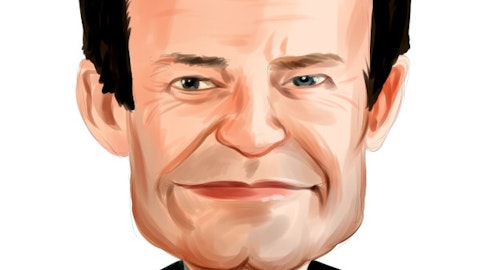Artisan Partners Asset Management Inc. (NYSE:APAM) Q3 2023 Earnings Call Transcript November 1, 2023
Operator: Hello and thank you for standing by. My name is Jason, and I will be your conference operator today. At this time, all participants are in a listen-only mode. After the prepared remarks, management will conduct a question-and-answer session and conference participants will be given instructions at that time. As a reminder, this conference call is being recorded. At this time, I will turn the call over to Artisan Partners Asset Management.
Unidentified Company Representative: Welcome to the Artisan Partners Asset Management business update and earnings call. Before we begin today, I would like to remind you that comments made during today’s call, including responses to questions may include forward-looking statements. These are subject to known and unknown risks and uncertainties, including, but not limited to, the factors set forth in our earnings release and detailed in our SEC filings. These risks and uncertainties may cause actual results to differ materially from those discussed in the statements, and we assume no obligation to update or revise any of these statements following the presentation. During today’s call, we will be discussing our Investor Day, which took place on September 27 in New York and online.
Materials from the Investor Day and a replay of the presentation are available on our Investor Relations website. The Investor Day presentation also included forward-looking statements that were current as of the time they were made, but have not been updated to reflect any changes in circumstances. In addition, some of our remarks today will include references to non-GAAP financial measures. You can find reconciliations of those measures to the most comparable GAAP measures in the earnings release and the supplemental materials, which could be found on our Investor Relations website. Also, please note that nothing on this call constitutes an offer or solicitation to purchase or sell an interest in any Artisan investment product or a recommendation for any investment service.
I will now turn it over to Eric Colson, our CEO.
Eric Colson: Thank you for joining the call or reading the transcript. On September 27, we held our first Investor Day. After more than 10 years as a public company, we wanted to review who we are as an investment firm, describe how we have evolved our business and compounded wealth for clients and highlight the team and platform we have in place for future growth. The title of the Investor Day was the power of quality compounding. We wanted to reinforce the power of compounding, the eighth wonder of the world and reinforce the power and potential of Artisan Partners, a firm designed and operated the compound wealth careers and outcomes over long periods of time. As an illustration, a hypothetical portfolio of $1 million invested at inception of each of Artisan’s 28 strategies launched to clients would have grown to nearly $117 million net of fees as of September 30, 2023.
This amount is nearly $43 million or 58% more than if the same amounts had been invested in the passive benchmarks most often used to assess our strategy’s performance. That’s a good example of the power of compounding and the long-term performance of Artisan Partners. Another goal of our Investor Day was to introduce more members of our business management team. We have a group of senior leaders who know the investment industry and are aligned with who we are as a high value-added investment firm. This group gives us the breadth and depth to continue our repeatable franchise development process, further expand our investment and business capabilities and keep the compounding process going long into the future. At the Investor Day, Jason Gottlieb, our President, led a detailed discussion of our franchise development process, the positioning and potential of our existing investment strategies and areas where we may expand in the future.
Today, Jason is joining C.J. and me, and I have asked him to update you on the status of our credit-oriented business as well as opportunities we see in emerging markets.
Jason Gottlieb: Thank you, Eric. Our expansion into credit is a case study in our repeatable franchise development process. Slide 2 should look familiar. It shows the spaces we are focused on and our methodical build-out in these areas. As we discussed at the Investor Day, we pursue asset classes where we see the overlap of exceptional talent, large investment opportunity sets for differentiation and alpha generation, large addressable markets with long-term allocators and good fit with our strategic expansion of our business model and operating platform. 10 years ago, we did not have any of these capabilities shown on this slide. Today, we have an investment offering in each of these areas except private credit. Earlier this week, we completed the first close of the Artisan dislocation opportunities fund.
The fund is a closed-end drawdown vehicle managed by Bryan Krug and the credit team. Throughout his career, Bryan has exploited opportunities in dislocated markets. Dislocation opportunities fund is designed to provide clients with targeted access to this core competency of the team. When I think about the lineup on this slide, what is most notable to me is that we have demonstrated that our philosophy and process works for clients and talent beyond public equities. In short, these strategies have performed. Since inception and after fees, the high income strategy has delivered 193 basis points of average annual alpha. Credit opportunities, 751 basis points; floating rate, 50 basis points; global unconstrained, 603 basis points; emerging market debt opportunities, 939 basis points; and emerging market local opportunities, 255 basis points.
During the third quarter, we continued to capitalize on this success and grow these businesses. We onboarded a $425 million institutional account and emerging market local opportunities. We onboarded a $250 million institutional account in global unconstrained and the high income strategy had another strong quarter of flows, bringing year-to-date net inflows to over $1 billion for that strategy. Looking ahead at the near term, we are particularly focused on credit opportunities and global unconstrained strategies. Both have outstanding track records with differentiated portfolios. We will also continue to round out and further diversify the high-income business and execute on early opportunities for the EMsights Capital Group. While we have made significant progress in expanding our credit capabilities, we are still in the early innings.
We have a tremendous opportunity with our two existing teams, and there is great potential to leverage our operational platform with additional fixed income talent. As we move forward, we expect to do more in high value-added credit, but we will remain patient for the right opportunities that are consistent with our repeatable process. Turning to Slide 3. With the addition of the EMsights Capital Group, we now offer five emerging markets investment strategies, three refocused on equities and two focused on credit. We don’t include global unconstrained as an EM strategy given its broad mandate to seek return and manage risk across developed and developing markets. It is no secret that emerging markets investing has been rough. Over the last decade, the MSCI EM Equity Index has returned 2.07% annually compared to 7.55% for the ACWI Index and 11.91 for the S&P 500.
Flows haven’t been good either. In 2022, $90 billion flowed out of the EM debt strategies and $4 billion flowed out of EM equity strategies. 2023 has seen a continuation of these trends in EM debt with EM equities seeing modest inflows. We take a long-term approach. Emerging Markets accounts for over 40% of global GDP and even greater share of global growth. Emerging Markets offers a large and growing investment opportunity set. There is ample opportunity for differentiation and alpha and clients want to need active risk management. Yes, allocators are dialing down EM allocations right now, especially to China. But long term, we believe that emerging markets will be an important source of return and diversification for our sophisticated allocators.

While others are retrenching from emerging markets, we continue to move forward carefully and with discipline. We have long experience in emerging markets. We launched the Artisan Sustainable Emerging Markets strategy in 2006 and Artisan Developing World strategy in 2015. More recently, in addition to launching the EMsights Capital Group, we have built out our China Post venture team with seven individuals operating out of Hong Kong office. Our Developing World team now has talent in Hong Kong as well, and we recently obtained regulatory approval to execute trades from Hong Kong and placed our first trades from there in October. We have no illusions about the challenges presented by geopolitics and China, in particular. These take judgment and patience to navigate, but we have never tried to time markets or short-term demand.
We look for the overlap of talent, opportunity and business fit. When we find it, we move forward, we build, and we remain patient. Over the long term, we continue to believe that Emerging Markets will present opportunities that allocators want and need to access. We have today and will have in the future a compelling lineup of talent and strategies to fit those needs.
Eric Colson: Thank you, Jason. Slide 4 summarizes our growth since 1995. Our growth has been a function of compounding wealth for existing clients, adding new capabilities and assets over time and patients. As we’ve added investment capabilities and assets, we’ve invested in the distribution capabilities that support them. At the Investor Day, listeners heard from our Head of Global Distribution, Chris Krein, our distribution model is a hybrid approach. Traditionally, our investment team specific business leaders have marketed and serviced institutional clients and consultants, while our centralized sales teams have marketed and serviced their own channels or geographies. We have hired excellent people, provided compelling incentives and sold and serviced across multiple channels and geographies with modest headcount and total spend.
Over time, though, the number and complexity of our investment strategies has grown considerably. And historical distribution channels are converging, making distinctions like institutional and intermediary less relevant. But it takes to sell and service as a sophisticated asset allocator is increasingly similar whether it’s a pension fund, institutional consultant, broker-dealer research department or family office. We are involving to increase intentionality and focus by improving alignment between our distribution professionals, content and marketing and data. We will continue to have high caliber talent and compelling incentives, but we are creating more structure and coordination, more clearly delineating sales and service responsibilities.
We are clarifying sales priorities, and we’re producing more investment content and better coordinating that content with sales and service efforts. And we are collecting, generating and using more data to improve the effectiveness and efficiency of our sales and service groups. Let me give you two examples to illustrate this evolution. First, we recently hired our first individual to focus exclusively on marketing our alternative strategies. His near-term focus is on marketing the credit opportunity strategy as well as related co-investment style opportunities that are a derivative of what the credit team does such as dislocation opportunities. Second, we are identifying specific strategies where we have compelling near- and medium-term opportunities and aligning people, resources, content and data to increase our focus and improve our feedback loops.
These more structured marketing efforts increased the probability of near- and medium-term success and serve as a model for the future. All of this evolution is consistent with who we are and how we have historically evolved. We have always sought to align people, resources, incentives and opportunities. At the Investor Day, we also described why we are confident, we will continue to compound wealth for clients, scale our newer strategies, add additional capabilities and continue to generate high-quality outcomes for our clients, employees and shareholders. We have expanded across more investment teams, asset classes and geographies. We have a repeatable process for identifying, recruiting, onboarding and partnering with investment talent. Our operational platform has more capabilities than ever.
We are evolving our distribution model, and we have in place a business management team with deep industry and Artisan-specific experience that is extremely well positioned to move us forward. I will now turn it over to C.J. to discuss our recent financial results.
C.J. Daley: Thanks, Eric. The decline in equity markets during the quarter drove our assets under management down to $136.5 billion as of September 30. That’s a 5% decrease from the June 30 AUM and 7% higher than our AUM at the start of 2023. Declines in global market indices contributed meaningfully to the decline in our AUM. Net client outflows primarily in global equity mandates also contributed to the AUM declines. Average AUM was $142.2 billion for the quarter, up 2% compared to last quarter and up 7% compared to the prior year September quarter. Year-to-date average AUM was $139 billion, down 5% from last year. Our complete GAAP and adjusted results are presented in our earnings release. Revenues in the quarter increased 2% compared to last quarter on higher average AUM.
Compared to the third quarter of 2022, revenues were up 6% on higher average AUM. Performance fee revenue has been insignificant since 2021. We are on track to earn some performance fees in the fourth quarter although the amount remains relatively small as only 3% of our AUM have performance fee billing arrangements. Adjusted operating expenses for the quarter increased 1% sequentially and due to an increase in incentive compensation expenses in line with higher revenues. Adjusted operating income increased 4% in comparison to the previous quarter and increased 5% compared to last year’s third quarter. On a year-to-date basis, revenues were down 5% compared to 2022 on lower average AUM. Adjusted operating expenses were generally flat compared to the 2022 nine-month period.
The decrease in incentive compensation expenses on lower revenues was offset by an increase in fixed compensation costs related to annual merit increases and a 6% increase in our number of employees compared to September 2022. Our headcount increases continue to be in line with our strategic growth plans and were primarily targeted to investment, distribution and marketing teams to support our growth initiatives. Travel expenses remain around 35% higher than last year, driven by increased travel related to our global investment strategies and client activity and firm events such as the Investor Day we held in late September. As a result of lower revenues, year-to-date adjusted operating income and adjusted net income per adjusted share were both down 15% compared to the 2022 year-to-date period.
Full year expense projections remain consistent with the guidance I provided on the February earnings call. Turning to Slide 10. Our balance sheet continues to support our operations and seed capital needs and provides a healthy cash dividend. We currently have approximately $140 million of seed capital invested in sponsored investment products with significant amounts of realizable capacity. The ability to support all of these objectives is only possible because of the strong cash flows generated by our business. In addition, the $100 million revolving credit facility remains unused. Given the rise in interest rates, our excess working capital cash contributed an additional $3.5 million of interest income in 2023 compared to the 2022 year-to-date period.
Consistent with our dividend policy, our Board of Directors declared a quarterly dividend of $0.65 per share with respect to the September 2023 quarter, which represents approximately 80% of the cash generated in the quarter and an 8% annual dividend yield based on our recent stock price before factoring in the special annual dividend, we intend to declare in January. Our Board will consider the declaration of an annual special dividend at our January 2024 Board meeting. We expect we will retain some cash from the special dividend as we have in the past several years to support our growth initiatives. In the fourth quarter, we expect the Artisan funds to complete their annual income and capital gains distributions. Based on our current estimates and assumptions, we expect fourth quarter distributions to result in approximately $400 million of net client cash outflows from investors who choose not to reinvest their distribution.
As highlighted in our recent Investor Day, growth is not linear and takes time in patience, and we continue to demonstrate the patience and discipline to grow our business over time to produce durable and high-quality results. Slide 12 illustrates the results of our business model and philosophy. We have delivered quality outcomes for our shareholders since our IPO 10 years ago. We are confident that our commitment to investing in our business will drive future growth, and we remain focused on returning capital to shareholders to generate quality outcomes over long time periods. With that, I will turn the call back to the operator.
See also 50 Most Famous American Investors and 25 Bestselling Cars, Trucks, and SUVs of 2022 and 2023.
Q&A Session
Follow Artisan Partners Asset Management Inc. (NYSE:APAM)
Follow Artisan Partners Asset Management Inc. (NYSE:APAM)
Operator: [Operator Instructions] And our first question comes from John Dunn from Evercore ISI. Please go ahead.
John Dunn: Could you maybe spend a little time just kind of framing for us the puts and takes of the institutional side of the business right at this moment? And then maybe just a flavor of like the kind of consultant and institutional mindset and how conversations are going right now?
Eric Colson: Yes, sure, John. It’s Eric. The — just back and away even above the institutional marketplace, we’ve come off of a pretty big drawdown in ’22 and then a lot of uncertainty here in ’23. So, we’ve seen, in general, muted flows compared to ’20 and ’21. So the bigger flows that are happening in the institutional side are sticking out a little bit more. Primarily, they’ve been non-U.S. clients in our larger global equity strategies that have been rebalancing or derisking or acknowledging that there’s been regulatory change, which has occurred more in Australia. So you’ve seen more activity there. And as we look at the put and the take, the flip side is looking forward, and there’s quite a bit of cash buildup that we’ve seen in money market funds.
We’re starting to see more people look at their targeted asset allocation and where to put that to work. So, one of the areas we’re looking at on a go forward is people rebalancing back to Emerging Markets and rebalancing into areas of interest, which is fixed income and alternatives. And more recently, you’ve seen a pickup in the dispersion of — in individual securities within indexes showing an interest leaning towards active management. So, I think the muted year so far with an expectation of money getting put to work next year back to targeted asset allocation.
John Dunn: Got you. And then maybe just on the three new mandates that you got recently. Maybe just because it seems like they came together pretty quickly, like could you give us a flavor of how those came to be? And then also, is there more — might we expect some more activity in those three areas in the medium term?
Eric Colson: Yes, certainly. We — as everybody is aware, we brought on the EMsights Capital Group and focused on the EM debt as well as the global unconstrained, the type of investments in Emerging Market debt either requires a larger scale separate account or a pooled vehicle. The earlier investments have been in the larger separately mandated. We have a good interest in the institutional marketplace around these mandates. And we’re starting to build a nice track record in the pooled vehicles and expect that we would have a forward lean in smaller allocations into the pooled vehicle is our expectation there. So we think it’s — the EMsights’ team is going as expected. We spent the early months building out the foundation, bringing in the team and allowing the team to put the proper foundation to build a strong track record.
The track record is looking as we expected, which was a high value-added Emerging Market debt and global unconstrained strategies. And now we’re out in the marketplace seeking early investors, which we found in the separate accounts and now continuing to sell with the pooled vehicles.
Operator: Our next question comes from Alex Blostein from Goldman Sachs. Please go ahead.
Alex Blostein: I was hoping we could build on the discussion around Emerging Markets, both in equities and debt. And the point you made around allocated is pulling back from Emerging Markets in the last year or so is, I guess, perhaps not too surprising. But when you talk to consultants and institutional allocators and distribution platforms, what do you see as the catalyst to perhaps reignite some of the interest in the asset class? And how are you positioning Artisan to ultimately capitalize if that trend reverses?



